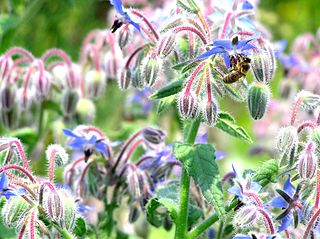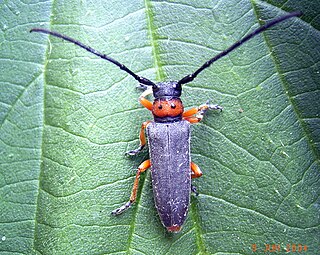
Boraginaceae, the borage or forget-me-notfamily, includes about 2,000 species of shrubs, trees, and herbs in 146 to 154 genera with a worldwide distribution.

Cynoglossum is a genus of small-flowered plants in the family Boraginaceae. It includes 81 species native to Eurasia, Africa, New Guinea, and Australia.

Cerinthe is a genus of flowering plants in the family Boraginaceae, known as honeyworts. The genus is characterised by a calyx made up of separate, rather than fused, sepals, a tubular corolla, and the schizocarpic fruit that divides into two parts at maturity, unlike most members of the family, where the fruit splits into four nutlets. The genus has a circum-Mediterranean distribution, ranging from the Irano-Turanian Region in the east to Morocco in the west.

Cynoglossum amabile, the Chinese hound's tongue or Chinese forget-me-not, is a species of flowering plant in the family Boraginaceae, native to Asia. A hardy annual growing to 50 cm (20 in), it has hairy leaves and cymes of sky-blue flowers in late summer. This plant, closely related to the common forget-me-not of temperate gardens, is also grown as an ornamental. In cultivation in the UK it has gained the Royal Horticultural Society's Award of Garden Merit..

Cynoglossum officinale is a herbaceous plant of the family Boraginaceae.

Boraginoideae is a subfamily of the plant family Boraginaceae s.s, with about 42 genera. That family is defined in a much broader sense in the Angiosperm Phylogeny Group (APG) system of classification for flowering plants. The APG has not specified any subfamilial structure within Boraginaceae s.l.
Dialectica aemula is a moth of the family Gracillariidae. It is known from Australia, India (Bihar) and Nepal.

Phytoecia is a genus of longhorn beetles of the subfamily Lamiinae,
Phytoecia gianassoi is a species of beetle in the family Cerambycidae. It was described by Sama in 2007 and later reclassified to the subgenus Coptosia within the genus Phytoecia.

Phytoecia puncticollis is a species of beetle in the family Cerambycidae. It was described by Faldermann in 1837. It is known from Russia, Azerbaijan, Georgia, Iraq, Armenia, Turkey, Iran, and Turkmenistan. It feeds on Eryngium billardierei.

Phytoecia affinis is a species of beetle in the family Cerambycidae. It was described by Harrer in 1784, originally under the genus Leptura. It has a wide distribution in Europe.

Phytoecia caerulescens is a species of beetle in the family Cerambycidae. It was described by Scopoli in 1763, originally under the genus Leptura. It has a wide distribution in Europe, and has been introduced into Australia. It feeds on Echium vulgare, Lappula squarrosa, Anchusa officinalis, Lithospermum officinale, and Cynoglossum officinale.
Phytoecia uncinata is a species of beetle in the family Cerambycidae. It was described by W. Redtenbacher in 1842. It has a wide distribution in Europe. It measures between 6 and 9 mm. It feeds on Cerinthe minor and Cerinthe glabra.

Phytoecia caerulea is a species of beetle in the family Cerambycidae. It was described by Scopoli in 1772, originally under the genus Leptura. It has a wide distribution in Europe.

Cynoglossum lanceolatum Forssk. is closely related to and grades into Cynoglossum coeruleum Hochst. ex A.DC. It is a much-branched biennial plant, occurring widely with an anthropogenic distribution, harvested from the wild and used as both food and medicine. This species was first described by the Swede Peter Forsskål in 1775 in Flora Aegyptiaco-Arabica 41.

Andersonglossum boreale, known as northern wild comfrey or just wild comfrey, is a species of flowering plant in the borage family, Boraginaceae. It is native to boreal coniferous and mixed forests in North America, from Nova Scotia to British Columbia and Yukon in Canada, south to New Jersey and Indiana in the United States. It is often found in rocky or sandy soils. It is extirpated from many of the southern parts of its range.

Cynoglossum germanicum, the green houndstongue, is a flowering plant species, in the family Boraginaceae, which is native to Europe.

Cynoglossum zeylanicum, also called the Ceylon hound's tongue, Ceylon forget-me-not, and Indian hound's tongue, is a species of flowering plant in the family Boraginaceae. It is found throughout Asia. It has also been introduced to the Americas.

Cerinthe major, called honeywort along with other members of its genus, is an annual species of flowering plant in the genus Cerinthe, native to the Mediterranean region, and introduced to New Zealand. Gardeners have a choice along a spectrum of cultivars ranging from Cerinthe major subsp. major, with sea-green bracts and yellow flowers, to Cerinthe major subsp. purpurascens with blue bracts and purple flowers.















